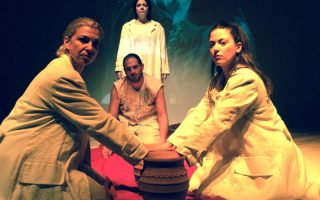When the Sitia region became a member of the UNESCO Geopark family, we had no idea just how much positive change this would bring!
This new aspect of tourism “Sitia Geopark”, is proving to be a considerable point of interest, especially in the alternative tourism market. The natural environment is no longer an obstacle for tourism development, on the contrary it is a great attraction for visitors.
We are seeing increasing interest in our Geopark from our customers, both individuals and tour operators from all over Europe. Sitia Geopark recently took part in online exhibitions’ of alternative tourism with Belgium, Poland, UK, Germany and France. We spoke with tour operators, journalists and travel writers. This type of tourism was something new to many of them and we detected great interest.
This is because our new venture is different and better than anything previously on offer!
Before our area was designated as a Geopark, the tourism product sold by the area of Sitia was Crete’, as promoted by all the island – Chania, Rethymno, Heraklion etc. Impossible competition!
“Sitia Geopark” is a totally new autonomous venture, found only in our area, fully compatible with alternative forms of tourism. It seems therefore that our region is slowly beginning to take a leading role, by fulfilling the needs of the modern tourist. The classic product of mass tourism and the trio of sun, sea and antiquities has completed its life cycle in these changing times and is naturally evolving into special and selective, ie alternative forms of tourism.
But what is “alternative tourism”?
And I quote the most appropriate description I can find: “Alternative tourism is the form of tourism, which is compatible with the social and environmental values of the region allowing both the local society and visitors to enjoy positive, worthwhile interaction and shared experiences. In other words, “alternative tourism” is the development that meets the needs both of the visitors and the region.
Three forms of alternative tourism have been developed and sold as package holidays to offices abroad in the last 12 years within the “Sitia Geopark” area.
The 1st alternative form of tourism is “walking tourism”. Over 25 marked routes are available with packages including accommodation, transportation, and guided tours for individual visitors as well as small groups of 6-15 people.
The 2nd form of alternative tourism – the largest alternative programme in our area for the last 18 years – is the sport of Windsurfing, which takes place on the beach of Kouremenos, Palekastro. The package includes accommodation in Palekastro area, transport and equipment (boat, sails) supplied by the 2 windsurfing stations located on the beach.
The 3rd form of alternative tourism is “cycling tourism”. Over 7 marked cycling routes are available within the Geopark area. The packages include accommodation in the area, transport and supply of city or mountain bike for individual customers or small groups of 6-15 people.
We are expecting a 4th very promising form of alternative tourism, “diving tourism”, to be added to our area with the creation of a diving park in the near future.
If asked today what the future tourism model for an area would be, I would say, 30% mass tourism and 70% alternative forms of tourism. The areas where mass tourism has prevailed show us that the above ratio is very difficult to achieve. To this end, we should consider the actual capacity of the area and we certainly need the support of government and the municipality.
Why choose 30% mass tourism? Mass tourism obviously controls the airlines and handles millions of people. Even though it creates many negatives in the host areas (for example Malia, Hersonissos, Faliraki, Rhodes, etc.), it also has 2 positives that we need in our area:
1) Direct flights from abroad to Sitia International Airport, offering easy and quick access to the destination and reduced package costs for customers.
2) New job opportunities in hotels/tourism for young people.
And why 70% alternative forms of tourism?
1) As far as revenue is concerned, one customer of alternative tourism equals
10 mass tourism customers.
2) It is more resistant to crises and pandemics. For example, regardless of the
Covid-19 pandemic, generally speaking small hotels, villas and apartments
in areas less developed developed continued to operate at a much lower
loss, whereas many large hotels and resorts remained closed in 2020 and
may well not open in 2021.
3) Not easily blackmailed by big tour operators.
4) Eco-friendly and local population-friendly as opposed to mass tourism.
5) The relationship between humans and the natural environment is restored.
6) Sustainable tourism development is created, by answering both the needs
of visitors and host areas, while protecting and increasing future
opportunities.
7) The local community profits the most as opposed to 2-3 people in the case
of mass tourism.
8) Repeat customers are created.
9) It attracts those in the high-end market with high standards, who would
never consider mass tourism.
This is dedicated to our future generations!
In no way do we want our actions of today to limit the ability of future generations to fulfill their own needs!
Kind regards
George Belibasakis
Web: https://www.sitia-geopark.gr/
TourMap: https://tours.nhmc.uoc.gr/geo/sitia/













